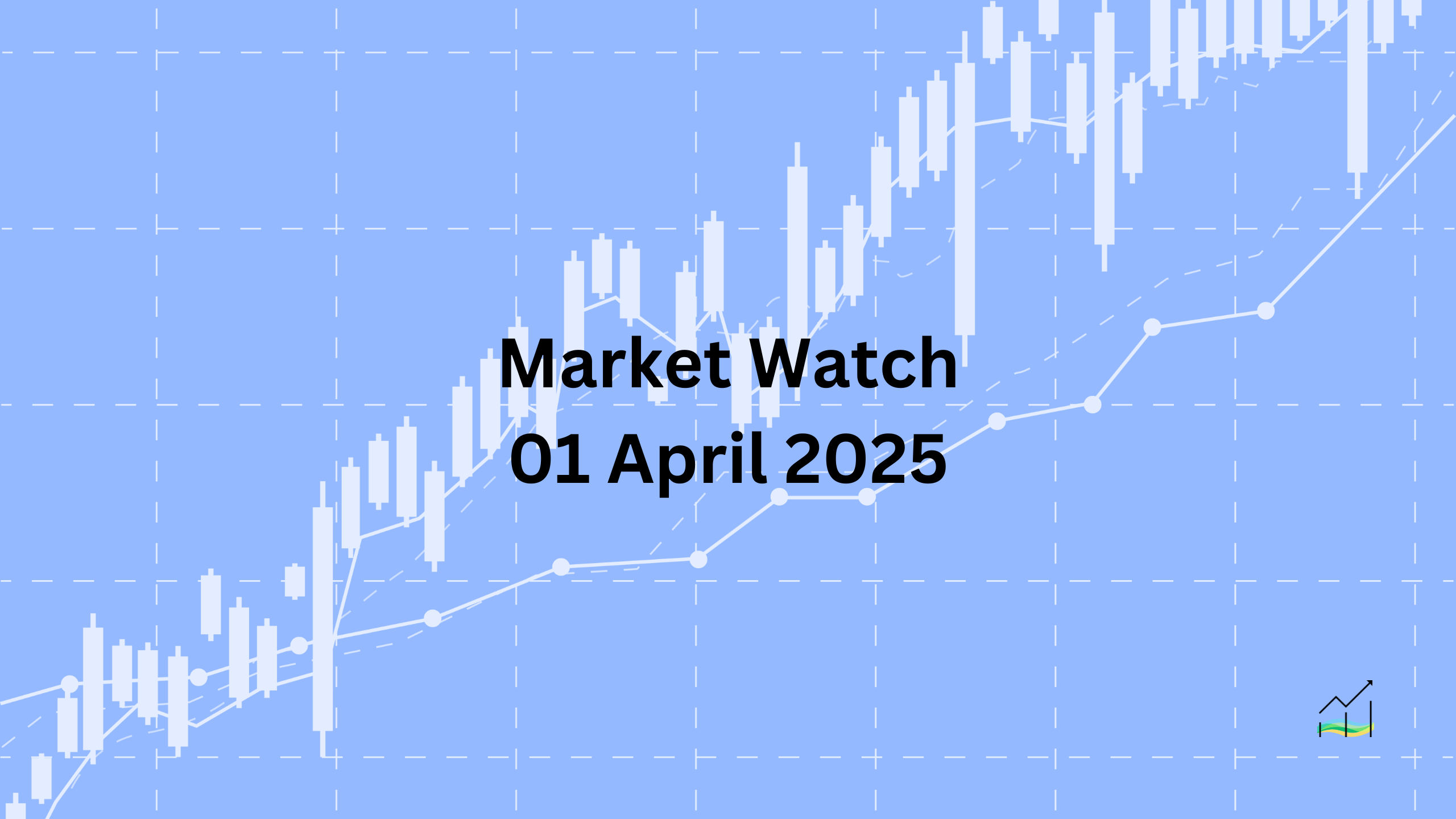01/04/2025 Market Watch

Tariff Decision Looms, Global Signals Mixed
Ahead of an expected US tariff announcement, markets are showing signs of cautious consolidation. With limited surprises in global economic data and a stabilising equity environment, attention now turns to US releases and their potential implications. Global investors remain focused on central bank policy cues, inflation dynamics, and evolving technical trends.
The US dollar is trading within yesterday’s range as the administration continues internal discussions on the scope of potential new tariffs. With no major shocks from recent data, the market tone remains measured. In Japan, the Tankan survey met expectations, offering no shift in Bank of Japan sentiment. Similarly, the Reserve Bank of Australia kept rates unchanged following its earlier rate cut, in line with market forecasts.
In the eurozone, inflation data matched estimates, while the unemployment rate fell to a new record low of 6.1%, a notable development even if not market-moving. In the US, upcoming economic releases include the JOLTS job openings report—now drawing less market attention than earlier in the cycle—and the ISM manufacturing index, expected to dip below the 50 mark, indicating a potential contraction. Auto sales may see a temporary lift as buyers look to get ahead of any tariff changes.
US equity markets bounced back impressively yesterday, filling early session gaps and providing a positive lead to Asia and Europe. All major Asia-Pacific markets except India posted gains, with Taiwan and Australia rising over 1%. European equities also advanced, with the Stoxx 600 climbing more than 1% and potentially ending a four-day losing streak. US futures are holding steady to slightly higher levels.
Despite the rebound in stocks, bond markets have remained firm. Yields in Europe are mostly 6–7 basis points lower, while the 10-year US Treasury yield eased slightly below 4.18%, edging closer to last month’s five-month low near 4.10%. Gold continues its strong upward momentum, reaching $2,149 before settling into consolidation. Meanwhile, oil prices remain supported, with WTI crude maintaining gains around the $71 mark after a 3% surge.
United States of America
Overview
The US Dollar is consolidating after testing its lowest level since October, while traders await key economic reports, a potential tariff announcement, and insights from the Federal Reserve. Although recent data shows signs of pre-emptive activity—possibly ahead of tariffs—the broader market tone remains cautious. A growing measles outbreak and warnings from global health authorities add to the sense of unease, reflecting deeper concerns beyond just economic headlines.
Economic Drivers
Underlying trends continue to reflect a mixed outlook. Businesses and households appear to be accelerating activity in anticipation of tariff-related disruptions, yet structural weaknesses remain.
- Job openings have nearly reversed the gains seen during the post-pandemic surge.
- Economic behavior may be front-loaded due to expected tariff changes.
- The ISM manufacturing index is expected to dip back below 50, suggesting renewed contraction.
- Auto sales likely held steady around 16 million annualised units, as in February.
- The US is facing a growing public health risk from measles, with outbreaks in multiple states and warnings extending to Mexico.
Data and Events
Market attention is centred on a series of important releases and statements scheduled this week, which may drive volatility.
- JOLTS Job Openings Report – Offers insights into US labour market slack.
- ISM Manufacturing Index – Forecast to fall below the neutral 50 level.
- Reciprocal Tariff Announcement (Tomorrow) – May reshape global trade dynamics.
- US Nonfarm Payrolls (Friday) – A key signal for labour market health.
- Fed Chair Powell’s Speech – Guidance on monetary policy and the economic outlook.
Price Action
The Dollar Index is consolidating after bouncing from 103.75, which marked the 61.8% retracement of the March low. It reached as high as 104.40 yesterday and is currently trading within a narrow range between 104.00 and 104.30. Resistance remains near last week’s high at 104.70, while the 200-day moving average and the 38.2% retracement of last month’s decline converge around 104.90, forming a significant technical barrier. The current sideways movement suggests the market is pausing ahead of key directional triggers.
Key Points:
- Dollar Index holding key support, consolidating between 104.00–104.30.
- Job openings and ISM data suggest a cooling US economy.
- Economic activity may be front-loaded due to tariff concerns.
- Auto sales stable, but growth remains subdued.
- Major events ahead: Tariff decision, jobs report, Powell’s speech.
- Measles outbreak adds to domestic risk landscape, with warnings from health authorities.
Australia
Overview
The Australian dollar has come under renewed selling pressure, breaking below key support levels as market expectations shift firmly toward further interest rate cuts. Despite steady retail sales data, weak momentum and dovish rate forecasts are weighing on the currency. The Reserve Bank of Australia held rates steady, as widely expected, but markets are now fully pricing in multiple cuts by year-end.
Economic Drivers
Underlying sentiment toward the Australian dollar remains bearish as soft economic momentum and monetary easing expectations dominate the outlook.
- The Reserve Bank of Australia left the cash rate unchanged at 4.10%, in line with forecasts.
- Markets are fully pricing in a rate cut at the next meeting in May.
- Futures indicate expectations for three rate cuts this year, with the year-end target rate projected slightly below 3.40% — the lowest in five months.
- Retail sales rose by 0.2% in February, but the two-month average (0.25%) is significantly lower than the early 2024 pace (0.65%).
- Weak consumer demand and declining rate expectations continue to dampen support for the currency.
Data and Events
Recent releases and policy decisions confirm the market’s dovish bias toward the Australian economy.
- RBA Rate Decision – Cash rate held at 4.10%, no surprise to markets.
- Retail Sales (February) – Posted a 0.2% increase, reflecting weaker consumption compared to early 2024.
- Interest Rate Futures – Now fully price in a May rate cut and three total cuts by year-end, lowering the expected year-end rate to below 3.40%.
Price Action
The Australian dollar broke below last week’s support near $0.6280, falling as low as $0.6220. It has not traded below $0.6200 since March 4 or closed below it since January 17. It is currently range-bound between $0.6230 and $0.6270, with momentum indicators still pointing downward. Options worth A$1.5 billion expiring Friday are positioned at $0.6200, a key level to watch.
Key Points:
- Australian dollar fell sharply after breaching key support near $0.6280.
- Currently trading between $0.6230 and $0.6270, with momentum still weak.
- RBA held rates steady; a May rate cut is fully priced in.
- Futures market now expects three rate cuts this year.
- Retail sales growth is slowing, adding to pressure on the AUD.
- A$1.5 billion in options expiring at $0.6200 could influence near-term price action.
Canada
Overview
The Canadian dollar continues to weaken as risk-off sentiment and looming tariff concerns pressure the market. A firm US dollar and ongoing equity market weakness have driven the currency lower for a third consecutive session. Despite a cordial weekend call between political leaders, there is no sign of tariff relief for Canada. Market focus remains on upcoming US trade announcements and Canada's manufacturing data.
Economic Drivers
The broader tone is driven by concerns over trade policy, soft manufacturing activity, and a souring risk environment.
- Risk-off sentiment is intensifying amid continued US equity weakness.
- Tariff concerns persist, especially as no relief appears forthcoming for Canada.
- Political developments offered no material change to trade outlook.
- Canada's manufacturing sector shows signs of contraction, with PMI likely down for the third straight month.
Data and Events
Key economic and political events this week are likely to shape short-term CAD direction.
- Canada Manufacturing PMI (March) – Expected to decline for the third month in a row, reversing gains seen late last year.
- US Reciprocal Tariff Announcement (Tomorrow) – A critical event for trade-exposed economies like Canada.
- US Employment Report (Friday) – Markets expect softer job creation and potential upside surprise in the unemployment rate.
Price Action
The US dollar extended its rally against the Canadian dollar, briefly rising above CAD1.4400 before easing back toward support around CAD1.4365. This marks the third straight daily gain, with the greenback closing above the 20-day moving average for the first time since mid-March. A confirmed break above CAD1.4400 opens the door to the CAD1.4450–1.4470 resistance zone.
Key Points:
- Canadian dollar weakens for the third session in a row.
- US dollar closed above its 20-day moving average vs. CAD for the first time since March 14.
- Tariff concerns and equity market declines fuel risk-off tone.
- No indication of US tariff relief for Canada despite recent political discussions.
- Canada's manufacturing PMI expected to decline again.
- A sustained move above CAD1.4400 could target CAD1.4450–1.4470.
- Markets eye US trade and jobs data later this week.
China
Overview
The Chinese yuan is trading weaker as the US dollar pushes higher, approaching key resistance levels. The People's Bank of China appears to be allowing greater daily fluctuations in the yuan fix, contributing to broader market volatility. While China’s Caixin manufacturing PMI remains above the key 50 threshold, the divergence from official data highlights an uneven recovery across sectors.
Economic Drivers
The currency landscape is being shaped by stronger US dollar momentum and more flexible central bank policy in China.
- The US dollar found support near CNH7.2530 and is gaining ground.
- PBOC is allowing greater variance in its daily yuan fix, introducing more market volatility.
- A more volatile fix may reflect efforts to balance policy goals with market pressures.
- Economic signals are mixed, with the Caixin manufacturing PMI showing slightly stronger performance than official data.
Data and Events
Recent economic and policy signals shed light on the evolving state of China’s currency and manufacturing outlook.
- PBOC Daily Fixing Policy (March) – Showed a notable shift, with more sessions deviating by 0.3% or more from the previous day’s fix compared to the tightly managed range in February.
- Caixin Manufacturing PMI (March) – Registered at 51.2, stronger than the official figure of 50.4 and slightly higher than last year’s reading of 51.1.
Price Action
The dollar has gained against the offshore yuan (CNH), advancing from support at CNH7.2530 to test resistance around CNH7.2810. This move approaches last week’s high near CNH7.2825. A break above this level could signal further upside. The rise above CNH7.2650 was a key trigger in this latest upward move.
Key Points:
- US dollar finds support near CNH7.2530 and moves higher toward CNH7.2810.
- Resistance lies near CNH7.2825, last week’s high.
- PBOC is allowing greater daily fluctuations in the yuan fix, diverging from February’s tight control.
- Caixin manufacturing PMI remains above 50, indicating moderate expansion.
- Divergence between Caixin and official PMI suggests sector-level imbalances in China’s recovery.
Europe
Overview
The euro is trading in a narrow range after recovering part of its recent losses. While some technical support is holding, shifting capital flows and speculation around investor sentiment are drawing attention. At the same time, eurozone inflation continues to ease, and the labor market remains resilient, with unemployment reaching a new record low.
Economic Drivers
Market tone is shaped by moderating inflation and speculation around shifts in European investment exposure to US assets.
- Eurozone headline inflation eased to 2.2% in March, down from 2.3%.
- Core inflation fell to 2.4%, from 2.6% previously.
- February unemployment dropped to 6.1%, the lowest on record, after four months at 6.2%.
- There are anecdotal signs of reduced European investment in US equities following last year's record $108 billion inflow.
- Broader speculation suggests investors may be rethinking US exposure, though cyclical explanations remain more likely than structural shifts.
Data and Events
Key eurozone data released this week point to stable but subdued economic trends.
- Preliminary March CPI – Headline at 2.2% and core at 2.4%, both slightly lower than February.
- Final March Manufacturing PMI – Came in at 48.6, confirming contractionary conditions.
- February Unemployment Rate – Fell to 6.1%, down from 6.2%, marking the lowest level in eurozone history.
Price Action
The euro retraced half of its decline from the March 18 high near $1.0955 to last week’s low around $1.0735, reaching $1.0845 before dipping to $1.0785 and settling at $1.0815. It is currently trading quietly between $1.0790 and $1.0830. Significant option expiries at $1.08 this week—totaling more than €5 billion—are likely to anchor short-term price action.
Key Points:
- Euro rebounded to $1.0845 before pulling back to a tight range around $1.0815.
- Option expiries near $1.08 may limit volatility midweek.
- Eurozone inflation continues to cool; core and headline CPI both declined in March.
- Unemployment dropped to a record low of 6.1%.
- Manufacturing PMI remains below 50, indicating contraction.
- Some European investors may be unwinding US equity exposure, but a broader shift remains unconfirmed.
Japan
Overview
The US dollar remains steady against the yen after briefly overshooting a key retracement level. A rebound in US Treasury yields and equities supported the dollar’s recovery, while option expiries near ¥150 are anchoring short-term moves. In Japan, the latest Tankan survey shows softening sentiment among large manufacturers and more cautious capital spending as businesses adjust to global trade tensions and a shifting economic outlook.
Economic Drivers
Japan’s latest economic indicators reflect a cautious business environment and a moderating labour market, while long-term inflation expectations continue to rise slightly.
- The Tankan survey revealed mild weakness among large manufacturers, while non-manufacturers held steady.
- Capex plans by large companies dropped to 3.1%, the lowest since Q1 2023, reflecting conservative sentiment at the start of the fiscal year.
- Business investment has followed a sawtooth pattern over recent quarters; Q4 2024 saw a 2.3% increase, while Q1 2025 is projected to slow to 1.2%.
- Five-year inflation expectations rose to 2.3% from 2.2% previously.
- February’s unemployment rate improved slightly to 2.4%, though the job-to-applicant ratio declined to 1.24, matching last year’s low.
Data and Events
Recent releases and market developments are shaping near-term expectations.
- Japan Tankan Q1 Survey – Showed softening sentiment among manufacturers and steady conditions for non-manufacturers.
- Capex Outlook – Large firms revised capital expenditure plans down to 3.1%, the lowest level in over a year.
- Inflation Expectations – Rose slightly to an average of 2.3% over the next five years.
- Labour Market Data (February) – Unemployment slipped to 2.4%, while the job-to-applicant ratio fell to 1.24.
- US Treasury Yields – Recovered from an intraday low of 4.17% to around 4.25%, supporting the dollar.
Price Action
The dollar briefly exceeded the 50% retracement of its March rally from JPY146.55 before rebounding alongside US yields. It reached a session high near JPY150.25 and is currently holding below JPY150.15. Options worth $2.2 billion expiring today at JPY150.00 and JPY150.03 are likely keeping the pair contained in the near term.
Key Points:
- Dollar rebounded after testing key retracement levels, supported by rising US yields.
- Currently capped below JPY150.15 due to heavy option expiries.
- Japan's Tankan survey shows soft manufacturing sentiment and cautious capex outlook.
- Long-term inflation expectations in Japan ticked higher.
- Job market softened slightly, with a lower job-to-applicant ratio despite a dip in unemployment.
- Business investment remains volatile, with growth likely slowing in Q1 2025.
United Kingdom
Overview
The British pound is trading within a defined range after last week’s volatility, with momentum indicators pointing lower and near-term pressure building. A break below key support could confirm a broader topping pattern. The economic calendar is light, but recent data reflects a slowdown in UK manufacturing and a stabilisation in house prices.
Economic Drivers
Sentiment around sterling is softening amid weakening momentum and signs of economic cooling.
- Momentum indicators are trending downward, suggesting reduced bullish pressure.
- The five-day moving average has crossed below the 20-day for the first time in three months.
- House prices are holding steady, with Nationwide's index showing a 3.9% year-over-year increase in March, down from December’s 4.7%, the highest since October 2022.
- Manufacturing activity continues to contract, with the latest data reflecting the weakest reading since late 2023.
Data and Events
Recent releases offer limited upside for sterling, with soft readings in key economic indicators.
- Nationwide House Price Index (March) – Unchanged at 3.9% YoY, indicating steady but slower growth.
- Final Manufacturing PMI (March) – Revised down to 44.9 from a preliminary 44.6, and lower than February’s 46.9; weakest since late 2023.
- Historical Comparison – The March 2023 PMI was 50.3, highlighting the year-over-year deterioration in manufacturing sentiment.
Price Action
Sterling is holding within a broad range between $1.2870 and $1.2990 after last Thursday’s wide swing. A decisive break below $1.2860 would confirm a broader topping pattern. On the upside, resistance remains near the four-month high at $1.3015 recorded on March 20. The downward crossover of the short-term moving averages reinforces the weakening momentum.
Key Points:
- Sterling is range-bound between $1.2870 and $1.2990, with resistance near $1.3015.
- A break below $1.2860 could signal a broader downtrend.
- Momentum indicators and moving averages suggest bearish tilt.
- Manufacturing PMI revised lower to 44.9, weakest since late 2023.
- House price growth is steady but slower, with no monthly change in March.
© 2025 SKONE Enterprise (003319453-V). All rights reserved.
The content on this site is for informational purposes only and does not constitute financial advice.


